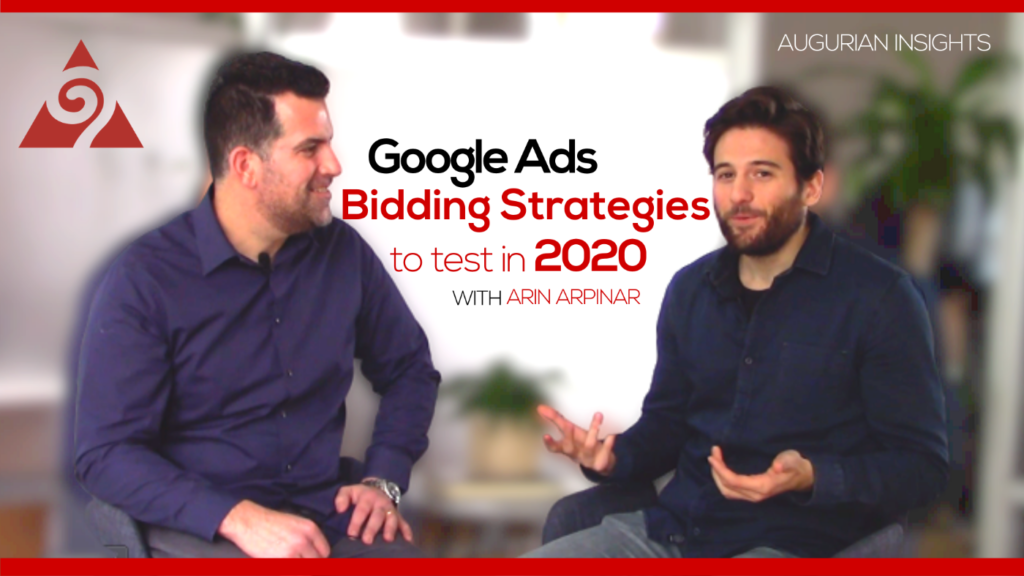To dominate the Google Ads landscape in 2020, advertisers must be strategic with how they bid. In this video, Senior Analyst Arin Arpinar outlines four bidding strategies that will level up your Google Ads in 2020. Find out exactly when you should use automated bidding strategies and how to structure your campaigns for optimal results.
Transcription
Josh Becerra: Hi, everybody. This is Josh Becerra from Augurian. I’m here with Arin Arpinar.
Arin Arpinar: Hey, Josh. How’s it going? Really excited to be here today.
Josh: I love your shirt, man.
Arin: Thanks, man. I like yours too. Where did you get it?
Josh: Blue, gray. Looking good.
Arin: Dress for success.
Josh: There we go. Tell me, what are we going to talk about today?
Arin: Today, we’re going to be talking about what bidding strategies you should test out in 2020.
Josh: All right. 2020 is just around the corner, so here we go. Give me first bidding strategy.
Arin: The first one I wanted to talk about was location proximity amplification bidding strategy. It’s really a mouthful. I did not come up with the name for that one.
Josh: Say it again.
Arin: Location proximity amplification.
Josh: All right, here we go.
Arin: Three times fast.
Josh: What’s it about?
Arin: We’ve tested it out with the higher ed clients. Basically, what it is, is that we looked at conversion rate and saw that people that were within 2 miles, 5 miles, and 10 miles had better conversion rates, leading closer to the actual physical location.
Josh: So the closer they got, the more they converted.
Arin: Exactly. I think that’s attributed to the fact that a lot of the courses are in-person too. Maybe they’re doing like an MBA program and they want to make sure that it’s close by.
Josh: Drivable.
Arin: Exactly.
Josh: It’s more like a geo-bullseye.
Arin: Yes, exactly.
Josh: That’s a lot easier to say.
Arin: I think that sounds a lot nicer. I think we’re going to have to rebrand it to that.
Josh: All right. The geo-bullseye, strategy number one. Strategy number two.
Arin: Strategy number two is something I use all the time. It’s just looking at device bid adjustments. We’ve seen a huge increase in the amount of traffic that’s coming from mobile.
Josh: Sure, makes sense.
Arin: Users are way more inclined to use their mobile devices now. With a nursing pillow client that we work on, we saw that like 70% of their traffic is actually coming through mobile, they’re converting more efficiently, and their costs are lower on mobile. We’ve created a 30% bid adjustment on mobile and a bid decrease on desktop. With that, we’re hoping to make sure that our budget is allocated to the most efficiently performing traffic.
Josh: Okay, you got another one?
Arin: Yes, I do.
Josh: All right, let’s hear it.
Arin: Now we’re getting into the automated bid strategies. This is one that I saw going through a couple of audits recently, where they had their account setup where all of their different match types were in the same ad group. What we like to employ, I think there’s another video on this, is an Alpha/Beta structure. What that is, is basically making sure that your alpha, your exact match keywords are in one campaign, and then your beta is your broad match modified keywords in the other campaign.
Josh: So they’re not competing with one another.
Arin: Exactly. That was what was going in these accounts, where they would have a broad mod or broad match keyword that was competing with the exact match, and they were using Target CPA and the CPAs were so different that it was constraining the amount of conversions that were going to be coming through.
What I like to do is, with your Alpha campaign, use a maximize conversions bidding strategy, because your cost per click is going to be a lot cheaper in that campaign, you want to make sure that you’re fully funding that campaign.
Next up, with your Beta campaign, you want to make sure that you have a Target CPA campaign setup. You’re still going to be going for those long-tailed keywords, but you’re going to be doing it in a more efficient way and trying to lead to a specific CPA that you have a little more control over.
Josh: Got it. That’s super smart. All right.
Arin: Final one that I want to talk about, this is a new one that I’m going to be trying out. I haven’t tested it yet, but another coworker was telling me about it. It’s building off of the strategy that I just talked about, and it’s using conversion action sets.
For one of our real estate clients, they have campaigns and goals set up for home buyers and home sellers, and other different types of goals. What I’ve done is create different groups for each of those goals, and then added those as the main goals that we want to be adjusting bids for. Those goals are higher value to us than, say, other goals on the account.
We’re going to be optimizing the campaigns to those now. I’m expecting just a slight drop in overall conversion volume, but it’s going to be higher-valued conversions going forward. Really driving the leads that matter.
Josh: That’s super smart. All right. Well, there you go. There’s a couple of tips for 2020. Thanks, Arin. Again, I like the look.
Arin: Absolutely, you too.
Josh: All right, here we go. See you, everybody.
Arin: Thanks.
Josh: Bye.
- Paid Media Marketing During a Recession - September 1, 2022
- The Google Ads ETA Sunset is Coming in July – Get Your Accounts Ready - June 2, 2022
- The Top 6 B2B Paid Media Channels to Test in 2022 - April 5, 2022



